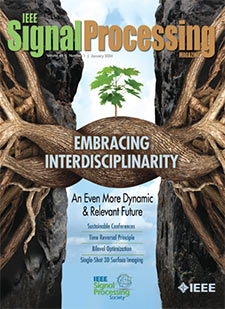- Our Story
- Publications & Resources
- Publications & Resources
- Publications
- IEEE Signal Processing Magazine
- IEEE Journal of Selected Topics in Signal Processing
- IEEE Signal Processing Letters
- IEEE/ACM Transactions on Audio Speech and Language Processing
- IEEE Transactions on Computational Imaging
- IEEE Transactions on Image Processing
- IEEE Transactions on Information Forensics and Security
- IEEE Transactions on Multimedia
- IEEE Transactions on Signal and Information Processing over Networks
- IEEE Transactions on Signal Processing
- IEEE TCI
- IEEE TSIPN
- Data & Challenges
- Submit Manuscript
- Guidelines
- Information for Authors
- Special Issue Deadlines
- Overview Articles
- Top Accessed Articles
- SPS Newsletter
- SigPort
- SPS Resource Center
- Publications Feedback
- Publications FAQ
- Blog
- News
- Dataset Papers
- Conferences & Events
- Community & Involvement
- Professional Development
- For Volunteers
- Information for Authors-OJSP
-
Home
Conferences Events IEEE JSTSP Article IEEE Signal Processing Magazine IEEE TIFS Article IEEE TMM Article IEEE TSP Article Jobs in Signal Processing Lectures Machine Learning Seasonal Schools Signal Processing News SPM Article SPS Distinguished Lectures SPS Newsletter Article SPS Webinar SPS Webinars SPS Webinar Series Webinar webinars
-
Our Story
What is Signal Processing?

The technology we use, and even rely on, in our everyday lives –computers, radios, video, cell phones – is enabled by signal processing. Learn More » -
Publications & Resources
-
SPS Resources
- Signal Processing Magazine The premier publication of the society.
- SPS Newsletter Monthly updates in Signal Processing
- SPS Resource Center Online library of tutorials, lectures, and presentations.
- SigPort Online repository for reports, papers, and more.
- SPS Feed The latest news, events, and more from the world of Signal Processing.
-
SPS Resources
-
Conferences & Events
-
Community & Involvement
-
Membership
- Join SPS The IEEE Signal Processing Magazine, Conference, Discounts, Awards, Collaborations, and more!
- Chapter Locator Find your local chapter and connect with fellow industry professionals, academics and students
- Women in Signal Processing Networking and engagement opportunities for women across signal processing disciplines
- Students Scholarships, conference discounts, travel grants, SP Cup, VIP Cup, 5-MICC
- Young Professionals Career development opportunities, networking
- Get Involved
-
Technical Committees
- Applied Signal Processing Systems
- Audio and Acoustic Signal Processing
- Bio Imaging and Signal Processing
- Computational Imaging
- Image Video and Multidimensional Signal Processing
- Information Forensics and Security
- Machine Learning for Signal Processing
- Multimedia Signal Processing
- Sensor Array and Multichannel
- Signal Processing for Communication and Networking
- Signal Processing Theory and Methods
- Speech and Language Processing
- Technical Working Groups
- More TC Resources
-
Membership
-
Professional Development
-
Professional Development
- Mentoring Experiences for Underrepresented Young Researchers (ME-UYR)
- Micro Mentoring Experience Program (MiME)
- Distinguished Lecturer Program
- Distinguished Lecturers
- Distinguished Lecturer Nominations
- Past Lecturers
- Distinguished Industry Speaker Program
- Distinguished Industry Speakers
- Distinguished Industry Speaker Nominations
- Industry Resources
- IEEE Training Materials
- Jobs in Signal Processing: IEEE Job Site
-
Career Resources
- SPS Education Program Educational content in signal processing and related fields.
- Distinguished Lecturer Program Chapters have access to educators and authors in the fields of Signal Processing
- PROGRESS Initiative Promoting diversity in the field of signal processing.
- Job Opportunities Signal Processing and Technical Committee specific job opportunities
- Job Submission Form Employers may submit opportunities in the area of Signal Processing.
-
Professional Development
-
For Volunteers
-
For Board & Committee Members
- Board Agenda/Minutes* Agendas, minutes and supporting documentation for Board and Committee Members
- SPS Directory* Directory of volunteers, society and division directory for Board and Committee Members.
- Membership Development Reports* Insight into the Society’s month-over-month and year-over-year growths and declines for Board and Committee Members
-
For Board & Committee Members
Popular Pages
Today's:
- Submit a Manuscript
- Information for Authors
- SPS Webinar: The Past, Present and Future of Automotive Radar for Active Safety and Autonomous Driving
- Video & Image Processing Cup
- IEEE Transactions on Image Processing
- IEEE/ACM Transactions on Audio Speech and Language Processing
- (MLSP 2024) 2024 IEEE International Workshop on Machine Learning for Signal Processing
- Awards & Submit Award Nomination
- IEEE Transactions on Signal Processing
- Signal Processing 101
- IEEE Transactions on Multimedia
- Membership
- Information for Authors-SPL
- (ICASSP 2024) 2024 IEEE International Conference on Acoustics, Speech and Signal Processing
- (SAM 2024) 2024 IEEE 13th Sensor Array and Multichannel Signal Processing Workshop
All time:
- Information for Authors
- Submit a Manuscript
- IEEE Transactions on Image Processing
- 404 Page
- IEEE/ACM Transactions on Audio Speech and Language Processing
- IEEE Transactions on Information Forensics and Security
- IEEE Transactions on Multimedia
- IEEE Signal Processing Letters
- IEEE Transactions on Signal Processing
- Conferences & Events
- IEEE Journal of Selected Topics in Signal Processing
- Information for Authors-SPL
- Conference Call for Papers
- Signal Processing 101
- IEEE Signal Processing Magazine
Last viewed:
- IEEE Transactions on Image Processing
- Information for Authors
- IEEE Transactions on Multimedia
- Submit a Manuscript
- Meeting Minutes
- About TASLP
- Call For Proposals: IEEE SLT 2024
- (MLSP 2024) 2024 IEEE International Workshop on Machine Learning for Signal Processing
- Standing Committees
- SPS Webinar: The Past, Present and Future of Automotive Radar for Active Safety and Autonomous Driving
- Speech and Language Processing
- Call for Proposal - SPS Challenge Program
- EDICS
- ALAN: Self-Attention Is Not All You Need for Image Super-Resolution
- IEEE Signal Processing Letters
Brännmark, Lars-Johan (Uppsala University), “Robust Sound Field Control for Audio Reproduction: A Polynomial Approach to Discrete-Time Acoustic Modeling and Filter Design” (2011)
You are here
Newsletter Menu
Newsletter Categories
Top Reasons to Join SPS Today!
1. IEEE Signal Processing Magazine
2. Signal Processing Digital Library*
3. Inside Signal Processing Newsletter
4. SPS Resource Center
5. Career advancement & recognition
6. Discounts on conferences and publications
7. Professional networking
8. Communities for students, young professionals, and women
9. Volunteer opportunities
10. Coming soon! PDH/CEU credits
Click here to learn more.
News and Resources for Members of the IEEE Signal Processing Society
Brännmark, Lars-Johan (Uppsala University), “Robust Sound Field Control for Audio Reproduction: A Polynomial Approach to Discrete-Time Acoustic Modeling and Filter Design” (2011)
Brännmark, Lars-Johan (Uppsala University), “Robust Sound Field Control for Audio Reproduction: A Polynomial Approach to Discrete-Time Acoustic Modeling and Filter Design” Advisor: Prof. Ahlén, Anders(2011)
This thesis is concerned with the design and analysis of robust discrete-time filters for audio equalization and sound field control in real reverberant environments. Inspired by methods in polynomial control theory, a unified framework for acoustic modeling and filter design is developed.
The work on modeling is centered on three main themes: First, the acoustic channel between a loudspeaker and a point in space is studied in time, frequency and space, and a polynomial matrix fraction description with diagonal denominator is selected as a physically motivated channel model. Second, the concept of sound field dimensionality, based on the Karhunen-Loève expansion of the sound field, is explored and integrated into the polynomial systems context. Third, a method for spatial interpolation of acoustic transfer functions is proposed and evaluated. The work on filter design can be categorized into single- and multi-channel methods. The single-channel problem concerns the improvement of the impulse and frequency responses of a single loudspeaker over a region in space. In the multichannel problem, a desired spatio-temporal sound field is approximated by the joint use of several loudspeakers.
Open Calls
Research Opportunities
Conference News
Education & Resources
Initiatives & Trends
New Books
Chapter & DL News
TC News
SPS on Twitter
- DEADLINE EXTENDED: The 2023 IEEE International Workshop on Machine Learning for Signal Processing is now accepting… https://t.co/NLH2u19a3y
- ONE MONTH OUT! We are celebrating the inaugural SPS Day on 2 June, honoring the date the Society was established in… https://t.co/V6Z3wKGK1O
- The new SPS Scholarship Program welcomes applications from students interested in pursuing signal processing educat… https://t.co/0aYPMDSWDj
- CALL FOR PAPERS: The IEEE Journal of Selected Topics in Signal Processing is now seeking submissions for a Special… https://t.co/NPCGrSjQbh
- Test your knowledge of signal processing history with our April trivia! Our 75th anniversary celebration continues:… https://t.co/4xal7voFER
Home | Sitemap | Contact | Accessibility | Nondiscrimination Policy | IEEE Ethics Reporting | IEEE Privacy Policy | Terms | Feedback
© Copyright 2024 IEEE – All rights reserved. Use of this website signifies your agreement to the IEEE Terms and Conditions.
A not-for-profit organization, IEEE is the world's largest technical professional organization dedicated to advancing technology for the benefit of humanity.








